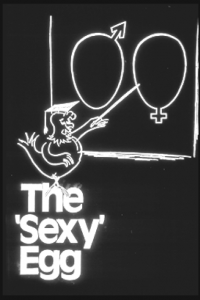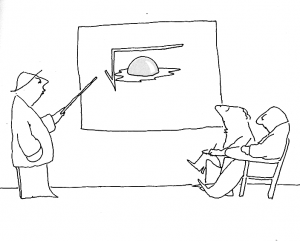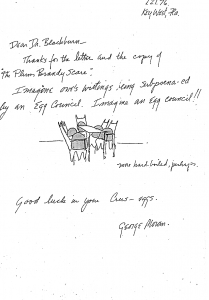“It Isn’t Always Fun.” – The Incredible Edible Egg
Full-page ads appeared in major metropolitan newspapers in the mid-1970s, depicting a small chick with a mortar board on its head, in an academic pose, pointing at a blackboard on which the message, changed every few days, read like this:
Cholesterol is necessary for:
The Transmission of Nerve Impulses, or,
The Synthesis of Sex Hormones, or,
Healthy Cell Membranes.

This quasi-intellectual message from the academic biddy was a misleading attempt to associate cholesterol with basic functions of life, including healthy cells, delicate sensations, and happy sexuality. The implication was that cholesterol in the diet (from eggs) is essential for this cholesterol in the body that did so many wonderful things. It was not explained that the body synthesizes its needed cholesterol from many food sources, including saturated fatty acids, and, in fact, requires no dietary cholesterol per se.
At any rate, such impressive ads for the purported health benefits of eggs attracted the attention of the American Heart Association, which complained to the Federal Trade Commission (FTC), which, in turn, set its staff promptly to investigate the claims. Shortly, the FTC instituted a “cease and desist” order against the American Egg Board, sponsor of the ads, calling the ads “false and misleading.” The Egg Board appealed and a hearing was set.
The American Egg Board, a quasi-public body with authority to levy taxes on egg producers to pay for ads and to lobby for the egg industry, cast about for expert consultants to testify about the importance of eggs in nutrition. At the same time, the FTC asked several U.S. investigators to contribute expert testimony. I was invited to be lead-off witness to develop evidence on the broad relationships among diet, blood cholesterol, and human health, as well as to address the validity of the claims in the American Egg Board ads. Some notorious types from Britain, Harold Keen, Michael Oliver, and John Yudkin, and Dr. Kummerow from the U.S., were the only experts the Egg Board could dig up to testify presumably in favor of eggs.
I consented to be an FTC witness for what I perceived as a public duty. I was also affronted by the carefully misleading egg messages. The day after I had accepted the charge, I received a phone call from Mr. James Fox of Chicago who announced that he was chief attorney for the National Commission on Egg Nutrition, the Egg Board. Brusquely, he began, “I am assuming, Dr. Blackburn, that you are a hostile witness in this case and therefore I have issued a subpoena which you will receive from the Federal Court in St. Paul, Minnesota. You will be ordered to produce for us all your correspondence from the last 10 years.”
Taken aback, in the midst of an academic work day, I made some inane comment such as, “That’s very interesting, Sir,” when he then said threateningly, “I’ll see you in court, doctor,” and abruptly hung up.
If his plan was to annoy me, the Egg Board lawyer succeeded. If it was to intimidate me into not testifying or into changing my testimony, he achieved the contrary. The idea of that rude rascal sorting through 10 years of my personal and professional correspondence was one I was not prepared to accept. I promptly called Tom Keller, a neighbor friend and my personal lawyer from a prestigious firm in the Twin Cities. He made exactly the reassuring sounds I needed to hear:
“Why, Henry, that’s preposterous,” he said, and indicated that he would most certainly be interested in taking the case, pro bono, yet! He explained that, as witness for the government, I would have to make a deposition and be cross-examined by the Egg Board lawyers. But he assured me that we could immediately issue a request of the Federal Court in St. Paul to quash the subpoena in its “unacceptably broad terms” and to narrow the subject of my deposition to an area in which I had expertise.
We agreed that my deposition should be limited to my opinions, edits, and commentaries over the years on the dietary policy statements of the American Heart Association on whose nutrition committee I then served. The idea of yielding any correspondence, or even deposing and testifying about any scientific issue before this unpleasant chap from the Egg Board remained a bothersome canker. But after Keller’s assurances I was vastly relieved and felt less personally threatened.
The word spread like wildfire among my colleagues about the treatment I had received from the Egg lawyer. He had used similar but less aggressive approaches on Jeremiah Stamler and Bill Connor and others who had agreed to be witnesses for the government case against the Egg Board and its advertising firm. Dick Ross, president of the American Heart Association, called me as soon as he heard the news and suggested that I engage a lawyer for myself and that the association would pay my legal expenses. After discussion, we decided that it might be best if my testimony were given as an individual investigator and not as a member of the American Heart Association Committee on Nutrition and that I accept no financial support from the association. This left me a free, if highly exposed, independent agent and expert.
In time, arrangements were made for my deposition at our laboratory in Minneapolis. My lawyer, Tom Keller, was at my side and the Egg Board sent a different, younger lawyer up from Chicago along with a court reporter. We proceeded with a deposition taking several hours. In it, I learned a great deal more, I suspect, than did the Egg Board. I had been coached to limit my deposition to well-documented evidence, and I played dumb on areas of controversy or undocumented issues. I made notes of questions they asked and of every opinion that the substitute lawyer, not particularly well informed, expressed. From the questions posed, I learned what might be used in my cross-examination at the Washington, DC hearing, as well as something about the level of knowledge and preparation in their case. From Keller I picked up a few techniques I might employ to parry aggressive thrusts. And I learned the incidental information that the original lawyer who had threatened me so bluntly over the telephone was not only the chief attorney for the Egg Board but was himself a member of the Egg Board and, moreover, operated a chicken ranch in the Midwest. Talk about conflict of interest! From this experience, I prepared my comments and attempted to gird myself emotionally for the formal hearings to come.
Washington, D.C. FTC Hearing
The hearings eventually took place before a small audience in the somber FTC chambers in Washington, DC, under a benign, “good ol’ boy” judge. I bore the brunt of the first day’s barrage of questions and also the task of “reading” the scientific case into the record. There was only one discomfiting hitch for me, related to an event just before the hearing. I had been misquoted in a medical newsletter giving a precise estimate of the effect of a change of one milligram percent average serum cholesterol level on cardiovascular disease rates in the country, that, “the reduction of 1 milligram percent would reduce heart attacks by 25,000 a year,” when, in fact, I had made a much more circumspect statement about the association among different cholesterol levels and coronary death rates. I was not happy with the quote taken out of context, and was genuinely concerned that this would be recalled in my cross-examination. Then I might be forced on the defensive to explain or even renounce the claim. A clever lawyer, with consultation, could do a pretty good job of working me over on the precision and validity of this estimate.
The testimony moved forward briskly and the FTC lawyer allowed me free rein to develop the information, with only an occasional leading question. On cross-examination, the young Egg Board lawyer zeroed in on matters of fact, to each of which I was able to respond. He did not, however, have his facts firmly in mind and was generally poorly informed on most issues. It was easy, with direct and diplomatic replies, to “set the record straight” and to avoid his attempts to discredit my testimony. Feeling good about the way things were proceeding, I was still expecting a crippling blow at the end about the misquote from me on potential lives saved “by 1 mg. percent cholesterol lowering.”
The Egg Board lawyer suddenly changed his tactic, apparently attempting to “soften me up” before what he thought would be his crowning blow. He asked, ever so casually, “As a man of wide experience and undoubted culinary interests, can you describe for me, Dr. Blackburn, a typical meal in your house and what you drink with your meals?”
I indicated that I considered my personal eating habits irrelevant to this testimony but, encouraged by the judge to reply, gave him nevertheless the composition of a typical evening meal at home, Mediterranean style including wine. When the lawyer asked what type of wine, the judge whispered in my ear in a friendly but teasing fashion, “Probably ‘Ripple,’ huh, Doc?”
All testimony in, the young Egg Board lawyer then presented me, his lamb prepared for the slaughter, with a graphic display showing a scattergram of coronary death rates on the ordinate versus average dietary cholesterol intake on the abscissa. It was an ecologic correlation among 19 countries that I recognized had been prepared by our colleague in preventive cardiology, Jeremiah Stamler. The lawyer rose to his full, if modest height, asking dramatically if I would, “please identify the point on the scattergram representing the population with the highest coronary disease rates,” which I did: Finland. And would I also acknowledge, “the population with the lowest dietary cholesterol intake,” which I did. It was the same country, Finland.
With an “Ah-hah, Doctor,” (I have you now!) he asked, “And how do you explain, sir, that the country with the highest heart-attack rate in the world has among the lowest cholesterol intakes in the world?”
I replied, asking him, “Have you ever been to Finland and eaten there?”
Sputtering, he replied, “Why, no.”
“You are perhaps aware, nevertheless, that egg yolks are the principal source of cholesterol in the diets of most western nations?”
“I suppose so.”
“Actually, the Finns eat very few eggs, which explains their low dietary cholesterol intake. But, as you surely learned in your study of the scientific facts in this case, the principal determinant of population levels of blood cholesterol level is the habitual intake of saturated fatty acids rather than dietary cholesterol. While the Finns eat few eggs, they have the highest intake in the world of butter, saturated butter fat.”
The young lawyer reddened and muttered, “I have no further questions for Dr. Blackburn.”
I sat stunned. I couldn’t believe that he was going to slink away, not confronting me with the one possible real source of embarrassment, my misquoted estimate of lives saved from lowering blood cholesterol.
But it was all over.
The FTC lawyer asked desultorily one or two concluding questions in re-cross, including whether I considered the Egg Board advertising claims false and misleading. Having been forewarned by my lawyer about this question, I replied that in my professional opinion they were scientifically correct statements but appeared to me to be misleading. I testified that I had no opinion on whether the public might be misled, since I was no expert on public perceptions. This brought a neat and modest closure to the proceedings.
Sequel
For some time thereafter, I was treated as a minor hero by my colleagues for having carried through on testimony in the face of the Egg Board’s dirty tricks. I felt drained but not heroic. In the end, all came together in a satisfying fashion when the FTC order for the Egg Board to cease its false and misleading advertising was upheld by the hearing judge. The Egg Board did indeed cease and desist, and, in fact, remained quiet for some years. More recently it jumped on the health promotion bandwagon in public testimony for the National Cholesterol Education Program, publishing its own brochure containing the “desirable, elevated, and high-risk” levels of blood cholesterol. And it soon returned to traditional American hucksterism in its new advertising campaign called, “The Incredible Edible Egg!”
The Egg Board still supports nutritionists who publish ad seriatim poorly designed studies of the effect of adding an egg or two to an already average high-egg-yolk American diet, purporting to show no effect of eggs on blood cholesterol level. But its high-profile campaign against the American Heart Association, the National Research Council, and the Surgeon General’s dietary recommendations simply faded away. Meanwhile, per capita consumption of eggs fell from 350 a year in the 1950s to 225 in the 1970s. It has plateaued at the lower level with only a modest trend downward since that time.
A renewal is likely these days of the cholesterol clamor with the concern over such issues as oxidized lipoproteins in the blood and oxidized cholesterol in powdered egg yolks used widely in commercial baked products, and similar ramifications. Some have recently raised doubts in a contrary direction as a result of associations found between excess deaths from many diseases and the very low blood cholesterol levels present in a small fraction of the U.S. population. It apparently reflects a poorly understood risk associated with many biological extremes. There is again room for deliberate distortions about “cholesterol” by those inclined. Stay tuned!

In the midst of the considerable tension in preparing my FTC testimony I was amused by a chance encounter with the egg-theme cartoons of George Moran. They were almost as bizarrely imaginative as Salvadore Dali’s limp eggs, but the cartoon above, of rare serendipity, displayed the square root function of an egg yolk, with no prior knowledge by the cartoonist of the Keys Equation. The equation, of course, relates serum cholesterol change to the square root function of dietary cholesterol intake (which, of course, in the U.S. is mainly derived from egg yolks!).
When, in my enthusiasm for his egg cartoons, I wrote the artist and described my horrific adventures with the Federal Trade Commission and the Egg Council, it inspired the enclosed delightful reply:
